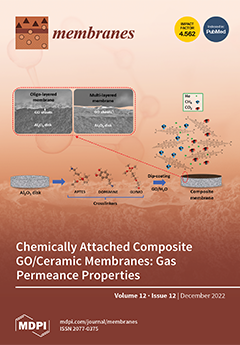Reverse water gas shift (RWGS) is attracting attention as one of the promising technologies for CO
2 conversion. Selective removal of H
2O from the reaction system can improve the CO
2 conversion beyond the equilibrium conversion of RWGS in a conventional
[...] Read more.
Reverse water gas shift (RWGS) is attracting attention as one of the promising technologies for CO
2 conversion. Selective removal of H
2O from the reaction system can improve the CO
2 conversion beyond the equilibrium conversion of RWGS in a conventional reactor. In this study, a conventional plug-flow reactor without membrane, and two types of RWGS membrane reactors using ZSM-5 membranes, were developed. The yield of CO without membrane (
Case 1) was almost the same as the equilibrium conversion. A membrane reactor (
Case 2) showed a CO yield 2–3% above that of a conventional reactor. From the results, the effectiveness of the dehydration membrane reactor for RWGS was verified. In addition, CO yield was further increased in the reactor made up of the combination of conventional reactor and membrane reactor (
Case 3). For example, the CO yields in
Cases 1,
2, and
3 at 560 K were 21.8, 24.9, and 29.0%, respectively. Although the CO yield increased in
Case 2, a large amount of raw materials penetrated through the membrane to the permeation side, and was lost. In
Case 3, H
2 and CO
2 permeation through the membrane were suppressed because of the existence of H
2O, resulting in the prevention of the leakage of raw material, and contributing to the high CO yield.
Full article






